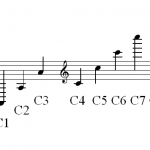SMPC Day 1: Session 4 (Learning and Pitch)
In rounding off the first day of SMPC I decided to skip a little between sessions. This tactic had the secondary benefit of helping me work off the enormous (and delicious) heap of noodles that I had consumed for lunch.
The first talk I attended in the final session was called ‘What makes a siren sultry?’ – I think you will agree a pretty great title! The talk was by John Purcell (High Point University, USA) and was focused on how attractiveness in singers impacts on people’s perceptions of their vocal quality and talent.
 The research is based on the well known ‘Halo effect’ within psychology, whereby specific judgement about a person can be influenced by an overall impression. In this case, attractiveness can lead people to assume all kinds of things about health, wealth, intelligence and kindness (just for examples). Would this Halo effect extend to judgments of musical performance?
The research is based on the well known ‘Halo effect’ within psychology, whereby specific judgement about a person can be influenced by an overall impression. In this case, attractiveness can lead people to assume all kinds of things about health, wealth, intelligence and kindness (just for examples). Would this Halo effect extend to judgments of musical performance?
John had 88 students rate the vocal skill and attractiveness of two pictured women – along with a recording of ‘their voice’. The two target photos were of ladies who were rated very attractive or not so attractive and people heard the same singer in the background, performing slightly different renditions of the Star Spangled Banner.

Participants were also put into the mind frame of ‘rejection’ or ‘acceptance’ by having them write stories about these themes in their own life before the experiment. The idea was that people who were in a rejection frame of mind would be more likely to have lower expectations of attractiveness.
Males in the acceptance condition were more likely to favour the voice that was paired with the most attractive picture, while males in the rejected condition showed no preference.
As predicted, females’ ratings were not impacted by the manipulation.
So it looks like facial attractiveness is part of what makes a “siren sultry”, to males in a good mood anyway! This work adds to a growing body of research into the relationship between musical performance and sexual selection.
The second talk I attended switched gears (and floors of the building) to present work on the nature of absolute pitch (AP). Stephen Hedger (University of Chicago, USA) has carried out a really interesting series of studies that have demonstrated that AP may not be so absolute.
 There is evidence from the literature that AP is not set in stone. In AP possessors (APers) we see variance of about 5 cents across a day and up to 33 cents across several days. Furthermore, pitches tend to go sharper as we age and certain drugs can lower AP. But can we manipulate a persons sense of AP just by a music listening task?
There is evidence from the literature that AP is not set in stone. In AP possessors (APers) we see variance of about 5 cents across a day and up to 33 cents across several days. Furthermore, pitches tend to go sharper as we age and certain drugs can lower AP. But can we manipulate a persons sense of AP just by a music listening task?
Stephen’s paradigm involved getting people with AP to rate tones as in tune or sharp or flat by 33 cents. AP-ers can do this very well of course. Then he asked them to listen to 45 minutes of classical music that was slowly phased to be flat, at a rate of 2 cents per minute over the course of the first movement. People do not notice that this is going on as they are focused on notating some score at the time. Stephen then repeats the first test.
 What he found was that APers now rated notes that were 33 cents flat as being ‘in tune’. However, this did not represent a general shift in their AP as they were able to correctly identify flat notes in a timbre that was not presented in the 45 mins of classical music. So, listening to flat music can temporarily shift categories in AP.
What he found was that APers now rated notes that were 33 cents flat as being ‘in tune’. However, this did not represent a general shift in their AP as they were able to correctly identify flat notes in a timbre that was not presented in the 45 mins of classical music. So, listening to flat music can temporarily shift categories in AP.
This finding demonstrates neatly that AP may reflect statistical experiences of music in the environment and is therefore a flexible perceptual mapping as opposed to one that is set in stone.
My final talk for the day was by Kai Siedenburg (McGill, Canada) who was looking into memory for timbre. I know, dear reader, memory – I am such a creature of habit!
 Kai was king enough to point out that it is the 150th anniversary of the publication of ‘On the sensation of tone’, the landmark book on tone perception written by Helmholtz. This book is still very influential in our modern theory of timbre. So many, many thanks to Herr Helmholtz!
Kai was king enough to point out that it is the 150th anniversary of the publication of ‘On the sensation of tone’, the landmark book on tone perception written by Helmholtz. This book is still very influential in our modern theory of timbre. So many, many thanks to Herr Helmholtz!
Timbre is a much under researched area of memory, certainly compared to pitch. This is mainly because it is harder to test and always you have to be careful to stop people re-coding sounds into verbal labels for the purposes of a memory test.
 In the present study Kai used timbre sequences of varied lengths and tested memory in musicians and nonmusicians. He also manipulated timbral similarity by using timbres from Steve McAdams‘ seminal work on multidimensional scaling of timbre.
In the present study Kai used timbre sequences of varied lengths and tested memory in musicians and nonmusicians. He also manipulated timbral similarity by using timbres from Steve McAdams‘ seminal work on multidimensional scaling of timbre.
Kai found a main negative effect of timbre similarity on memory, which is a nice result that goes with some of my earlier work showing a similarity effect in pitch sequence memory. He also found a sequence length effect, though until we are sure that verbal labeling can be ruled out I would treat this result with caution.
Learning about the processing of timbre sequences of course has important implications for our understanding of memory for speech, since timbre plays a crucial role here as well. I look forward to seeing how Kai’s paradigm develops in the future.
 All in all, an action packed and brain filling first day at SMPC2013. After this we all headed off to an outside green area for some well deserved drinks and a catch up with friends and colleagues. I promise you that I had just my allocated two beers before heading back to the hotel for a quick dinner and then to type up these blogs for you. The things I do for you, dear reader.
All in all, an action packed and brain filling first day at SMPC2013. After this we all headed off to an outside green area for some well deserved drinks and a catch up with friends and colleagues. I promise you that I had just my allocated two beers before heading back to the hotel for a quick dinner and then to type up these blogs for you. The things I do for you, dear reader.